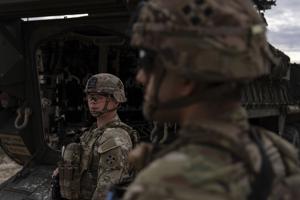UPDATE: The U.S. military has significantly expanded its role at the Mexico-U.S. border, a move that has sparked intense scrutiny and debate. Just days ago, an Army scout in Nogales, Arizona, utilized an optical scope to detect a potential illegal crossing, highlighting the military’s increased presence in the area.
This heightened military engagement comes as illegal crossings have reportedly dwindled to a 60-year low. Despite this decline, President Donald Trump has authorized the deployment of an additional 3,000 Border Patrol agents, alongside the tripling of military personnel to a total of 7,600 troops stationed along the border.
The new military operations are managed from a command center at a remote Army intelligence base in the Huachuca Mountains. Here, military commanders utilize digital maps to oversee movements and operations across the nearly 2,000-mile border. Until recently, border enforcement largely rested on civilian law enforcement, but military zones have now been designated, allowing troops to apprehend individuals trespassing on military property.
Army Maj. Gen. Scott Naumann, who is spearheading these operations, stated, “We can fly people into incredibly remote areas now that we see the cartels shifting course,” emphasizing the military’s readiness to respond rapidly to emerging threats. Troops are outfitted in full battle gear and are authorized to use deadly force if necessary, reflecting the serious nature of their mission.
The impact of this military presence is palpable. Sgt. Ana Harker-Molina, an immigrant from Panama and now a U.S. citizen, expressed the duality of the situation, noting, “Deterrence is actually boring,” yet underscoring her belief that the visibility of troops is effective in discouraging illegal crossings.
The Trump administration’s military strategy extends beyond mere border enforcement. It also includes protecting federal buildings and assisting Immigration and Customs Enforcement (ICE) operations in various states. Legal experts caution that this militarization of immigration enforcement walks a fine line, potentially violating the Posse Comitatus Act, which restricts military involvement in civilian law enforcement.
As the situation develops, experts warn that while apprehensions may be low now, they could rebound as summer heat diminishes. “We’re having some successes, we are trending positively,” Naumann noted, suggesting a long-term commitment to the mission with no defined endpoint.
With troops now equipped with 117 armored Stryker vehicles and more than 35 helicopters, the military is prepared for extensive surveillance and rapid response. As concerns rise over the implications of these developments, communities along the border are bracing for a new era of enforcement that intertwines military might with immigration control.
What happens next remains to be seen, but the stakes are high as the U.S. grapples with the complexities of immigration and border security. As this urgent situation continues to evolve, the implications for both national security and civil liberties are profound. Stay tuned for further updates on this critical issue.
